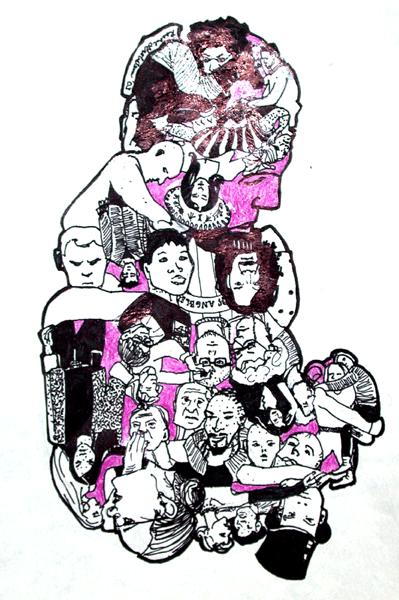Made available on Serendip
In association with Making Sense of Diversity: An Exploration, a world wide conversation

|
December 2, 2005
Nell Anderson, Vanessa Christman, Jody Cohen, Anne Dalke, Christina
Gubitosa, Molly McTague, and Rona Pietrzak
"Re-envisioning Class in and Beyond the Bi-Co"
Participants
Summary
Prepared by Vanessa Christman
Additions, revisions, extensions are encouraged
in the
On-Line Forum
| 
|
Jody Cohen began by informing the group that this conversation was a follow-up
to three prior discussions related to or touching on class— one last
spring, one earlier
this fall, and the one on
11/18 about Inclusion/Exclusion at Bryn Mawr.
Visions of Class. Jody and Anne Dalke then directed the group’s
attention to a visual
presentation. As the first image appeared on the screen, Anne explained
that she and Jody wanted to begin with a quote from Joseph Taylor’s will
(previously quoted in the Diversity Conversation on Inclusion/Exclusion)—that
his money be used to erect buildings “for the comfort and advanced education
and care of young women, or girls of the higher classes of society.” This
quote was followed by an image from the most recent Bryn Mawr Alumnae Bulletin,
a photo of students at the Bryn Mawr Summer School for Women Workers assembled
to perform a skit called “Wealth and Poverty” in 1930.
The group then looked at a variety of images that Jody and Anne had assembled—the
instructions were to look in silence, then be prepared to break into discussion
groups.
In our discussion groups, we asked, “Where did you see yourself in relation
to the pictures? Where did you hear yourself in relation to the language?”
Reactions. Once the large group reassembled, Jody and Anne
asked the following: “What was surprising in the group discussion/responses
to the pictures? Why are we afraid when class becomes visible?”
The group had the following reactions:
The upper class/poverty contrast photos at the beginning were obvious. Those
were extremes, but other pictures, such as the one of people gathered at a picnic
table, did not present as extreme a portrait of class.
Recognizing class differences is uncomfortable, because our associations are
tied to a history. Stereotypes seem to dominate; for example, that rich=snobby.
At first BMC was for the upper classes. The institution has changed to include
others, but what has changed here in order for that to work? (Has the institution
changed in a way that truly correlates to changes in the student body?)
Not everyone knows specifics of BMC history in regards to class. Some students
didn’t realize that the photo of (white) BMC students eating while a black
woman serves them was taken in a dining hall. Someone remarked that Wyndham
still feels that way, sometimes.
As for the photos the College rotates on its home page—many people said
“that’s not the BMC I know or belong to.” But when asked,
“What pictures WOULD you put there?” there were no answers. And
the language on the web site—“A community of equals” “Intellectual
exploration”—for many people that does not ring true. One person
admitted her goal was, necessarily, “just get a degree, for employment
and security.”
When we talk about income levels, it seems BMC is not diverse. In reality,
there are all kinds of income levels—18K, 40K. While those may seem like
incredibly low numbers to many of the student population, they do exist!
A student was asked, “Oh, you go to Bryn Mawr—is it still really
rich?” She’s a freshman and still trying to get a feel for it. What
would the answer be? She’s feels uncertain. Another way Bryn Mawr is perceived
from the outside is “You have your BMW princesses here and your intense
vegan lesbians.” Where does that leave people?
If you’ve been to private schools, it may be hard to know what the norm
[for class] is.
Time was out, so Jody wrapped the conversation. As she reminded
the group, this was the second session explicitly about class. Each time we
have one, she said, we break through a little more. She stated that she appreciates
people’s willingness to speak and looks forward to continuing this conversation.
| Return to Schedule for Friday Noon Conversations

| Bryn Mawr Conversations
| Archived
Forum
| Archive of Bryn Mawr Conversation
| General Conversation
| Serendip Home |
These pages are sponsored by the Bryn Mawr College Office
of Intercultural Affairs, the Center for Science and Society and the Serendip
website. Send us additional comments or suggestions at Serendip
© by Serendip 1994-
- Last Modified:
Wednesday, 21-June-2005 15:18:00 EST

